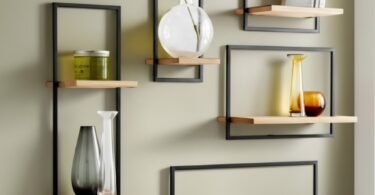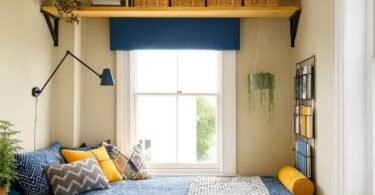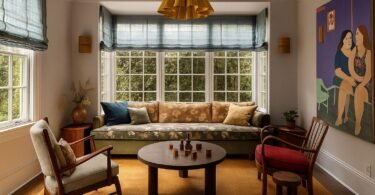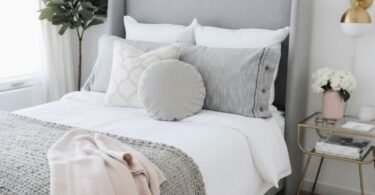So here’s the deal. Your kids are still camping out in your bedroom every single night. Maybe they start in their own beds but somehow end up sprawled across yours by 2 AM. Or maybe they flat out refuse to even try sleeping anywhere else. I get it. We’ve been there, and let me tell you, it gets old fast when you’re trying to have a conversation with your spouse and there’s a seven year old wedged between you asking for water.
But here’s what I’ve learned after years of dealing with this exact situation. Kids don’t just magically decide they love their own space. They need a reason to want to be there. Think about it from their perspective for a second. Your room probably has all the good stuff. It’s warm. It smells familiar. There’s background noise from the TV or your phone. Their room? It’s just four walls and a boring bed they associate with being alone.
Now flip that script. Some kids actually beg for their own space. They want privacy. They want to decorate their walls with posters of whatever they’re into this week. They want a place to call theirs where siblings can’t mess with their stuff. If you’ve got one of these kids, count yourself lucky. But you still need to make that room somewhere they actually want to spend time. Not just sleep time. We’re talking about creating a whole vibe that makes them excited to go to bed at night.
The secret weapon here? A really good bed. Not just any bed. I’m talking about the kind of bed that makes other kids jealous when they come over for playdates. The kind your kid wants to show off. And nine times out of ten, that means we’re looking at bunk beds. But before you roll your eyes and think this is just another furniture pitch, hear me out. There’s actual psychology behind why bunk beds work so well for getting kids comfortable in their own space.

Bunk beds tap into something kids naturally love. Height. Adventure. The feeling of having their own little fortress. When my oldest finally agreed to move into his own room, you know what sealed the deal? We let him pick out a bunk bed. Suddenly his room wasn’t just a place to sleep. It was his castle. His spaceship. His secret hideout. The bottom bunk became a reading nook during the day. The top bunk was where he felt like the king of his domain at night.
But let’s be real about the other side of this too. Maybe your kid is nervous about being alone. Maybe they had a bad dream once and now they associate their room with fear. Maybe they just genuinely enjoy your company and don’t understand why they’re being “sent away” at bedtime. These are real feelings that deserve attention. You can’t just buy a piece of furniture and expect all those emotions to disappear. What you can do is create an environment that gradually builds their confidence and independence.
Start small. Let them be part of the process. Take them furniture shopping. Let them touch the beds, climb on them in the store (within reason, don’t be those parents), and imagine what their room could look like. When kids have ownership over their space, they’re way more likely to actually want to use it. This isn’t about bribing them with stuff. It’s about helping them visualize a future where their room is the coolest spot in the house.
And if you’re worried about cost or space or any of the dozen other concerns bouncing around in your head right now, take a breath. We’re going to walk through all of that. The goal here isn’t to spend a fortune or turn their room into some Instagram-worthy showpiece. The goal is simple. Make a space your kid actually wants to be in. A space that feels safe, fun, and uniquely theirs. Once you nail that, the whole bedtime battle gets a whole lot easier.
Trust me on this one. I’ve watched kids transform from bedroom-avoiders to kids who literally race each other up the stairs at bedtime. The difference? They had a space that felt like it was made just for them. And more often than not, that transformation started with the right bed.

Finding the Perfect Bunk Bed for Your Space
Alright, let’s talk furniture. If you’re going to invest in making your kid’s room somewhere they actually want to sleep, the bed better be good. And I mean really good. Not just functional. Not just cheap. We need something that’s going to become the centerpiece of the whole room. The thing their eyes go to when they walk in. The thing they tell their friends about.
Here’s where I tell you to get your kids involved in this decision. I know what you’re thinking. They’ll pick something ridiculous covered in cartoon characters that you’ll hate looking at for the next five years. Maybe. But you know what? They’re the ones who have to sleep in it. Find a compromise. Set some boundaries about budget and safety, then let them have a say in style. When they feel like they picked it out themselves, they’re invested in using it.
The big question everyone faces is space. How much room do you actually have to work with? Most kids’ bedrooms aren’t exactly sprawling. You’ve got maybe 10 by 12 feet if you’re lucky. Toys everywhere. A dresser. Maybe a desk. Books scattered on the floor. The bed has to fit into all of that chaos while still leaving room for your kid to actually move around. This is where bunk beds become genius.
Bunk beds stack vertically. That frees up floor space for playing, dancing, building forts, or whatever weird thing kids do when they’re supposed to be cleaning their room. But not all bunk beds are created equal. Oh no. There’s a whole world of options out there, and picking the wrong one can leave you with buyer’s remorse and a kid who still ends up in your bed every night.
Let’s start with the basic bunk bed. You’ve seen these. Two twin beds, one stacked on top of the other. Ladder on the side. Simple. Clean. Functional. What makes these great is flexibility. When your kids get older or if you need to rearrange, you can split them into two separate beds. We did this when our youngest finally stopped having accidents at night and we felt comfortable putting him on the top bunk. Before that, both beds lived side by side in different rooms.
The basic bunk works best when you’ve got two kids sharing a room. Each kid gets their own bed, their own space, and you’re not sacrificing half the room to make it happen. The top bunk kid feels special because they’re up high. The bottom bunk kid has a cozy cave underneath the top mattress. Everybody wins. Just make sure you’re measuring your ceiling height before you buy. Nothing worse than getting it home and realizing the top bunk sleeper is going to smack their head every morning.
Now if you’re looking for something with a bit more style, check out futon bunk beds. These caught my eye when we were furnishing our playroom because they’re clever. The bottom “bed” is actually a futon. You know, those foldable couch-bed hybrids that every college student had in their dorm. During the day, it folds up into a couch. At night, it unfolds into a sleeping surface. The top is a regular mattress.

Why would you want this? Versatility. Maybe you only have one kid right now but you want to be ready for sleepovers. Maybe you want your kid’s room to have a hangout spot for when friends come over. The futon gives you options. And here’s the kicker. It actually takes up less space than a traditional bunk bed when the futon is in couch mode. You’re getting furniture that adapts to different needs throughout the day.
My friend used one of these in her daughter’s room and it changed everything. Suddenly the bedroom wasn’t just for sleeping. It became the spot where all the girls gathered during playdates. They’d sit on the futon, chat, do crafts, whatever. Then at night, boom, fold it down and it’s a bed again. The room got way more use, which meant her daughter actually wanted to spend time there. Smart move.
But let’s say you’ve got three kids. Or you want something that really maximizes your space in a different way. That’s when L-shaped or triple bunk beds enter the chat. These are the beds that make kids lose their minds with excitement. You walk into a furniture store and kids are climbing all over these things like they’re jungle gyms.
An L-shaped bunk bed is exactly what it sounds like. Two beds arranged perpendicular to each other forming an L. One bed is elevated, one is lower, and they meet at a 90 degree angle. This creates something magical underneath. A little nook. A hideaway. The perfect spot for a reading corner, a study desk, or just a place to chill. We’re talking about using vertical space and creating multiple functional zones in one piece of furniture.
The trade off? These take up more floor space than your basic stacked bunk. You need a decent sized room to make it work. But if you’ve got the space, the payoff is huge. Kids love having options. They love having different spots in their room for different activities. The top bunk for sleeping. The bottom bunk for lounging. The nook underneath for secret stuff. It’s like three rooms in one.
Triple bunk beds can work the same way. Three beds, usually arranged in an L or even a T shape. These are for families with multiple kids or for the kid who has friends over constantly. I’ve seen some creative parents turn these into shared sibling spaces where each kid gets their own level. The hierarchy practically writes itself. Oldest on top, middle child in the middle, youngest on the bottom. Just make sure you’re buying quality construction because three kids on one structure is no joke.

Here’s something not enough people talk about when shopping for bunk beds. Storage. Kids have so much stuff. Toys, books, clothes they refuse to put away, random collections of rocks or stickers or whatever they’re hoarding this month. Some bunk beds come with built in storage drawers underneath. Some have shelves on the sides. Some have literally nothing and you’re left trying to cram everything else into the remaining floor space.
When we bought our first bunk bed, we completely overlooked storage. Big mistake. We ended up with toys shoved under the bottom bunk in plastic bins that were constantly getting kicked over. The room looked messy no matter how much we cleaned. Second time around, we went for a bed with actual drawers built into the base. Game changer. Everything had a home. The room looked cleaner. The kids could actually find their stuff. Don’t underestimate how much easier your life gets when the bed does double duty as storage.
Trundle beds are another option worth mentioning. A trundle is basically a bed that slides out from underneath another bed. During the day, it’s tucked away and you’d never know it’s there. At night, you pull it out and suddenly you’ve got an extra sleeping spot. This works great if you don’t need a full bunk bed setup but you want flexibility for when kids have friends sleep over.
Some bunk beds let you convert the bottom bunk into a trundle. So you’ve got the regular top bunk, then the bottom section slides out on wheels. When you’re not using it as a bed, you can use that sliding drawer for storage. Blankets, off season clothes, board games, whatever you need to hide away. It’s like getting a bunk bed and a storage unit in one package.
The thing about trundles is they sit really low to the ground. Like, almost on the floor. This freaks some parents out because they worry about dust or if it’s comfortable. But kids? They don’t care. They think it’s fun to sleep that close to the ground. It feels like camping. Plus, for really young kids, there’s zero risk of them rolling out of bed and getting hurt. The closer to the floor, the safer the fall.
Now let’s talk money. Bunk beds range from a couple hundred bucks to well over a thousand. What’s the difference? Materials, construction quality, brand name, and features. You can find cheap particle board bunks at big box stores that’ll do the job for a few years. Or you can invest in solid wood construction that’ll last until your kids go to college. Neither choice is wrong. It depends on your situation.
If your kids are young and you know they’re going to beat the heck out of this furniture, maybe don’t drop a fortune on it. Get something sturdy enough to be safe but affordable enough that you won’t cry when they scratch it up or spill something on it. Kids are destructive. It’s not malicious. It’s just what they do. Accept it and plan accordingly.
On the flip side, if you’re planning to use this bed for years, through multiple kids, or you just really care about quality furniture, spend more upfront. A well made solid wood bunk bed can handle decades of use. It’ll look better. It’ll feel sturdier when kids are climbing on it. And if you ever need to resell it, quality furniture holds value way better than cheap stuff.
Safety is non-negotiable here. I don’t care how cute the bed looks or how good the price is. If it doesn’t meet safety standards, walk away. Look for beds with guardrails on the top bunk that are at least five inches above the mattress. Check that the ladder is secure and easy to climb. Make sure there are no sharp edges or protruding hardware that little heads can smack into. Read reviews from other parents about whether the bed wobbles or feels unstable.
We learned this lesson the scary way. Our first bunk bed seemed fine in the store. Got it home, assembled it, and realized the whole thing shook when our son climbed the ladder. Not a little wobble. A full on shake that made us both nervous every time he went up. We returned it the next day and bought something sturdier. Better to spend an extra hundred bucks than risk your kid getting hurt because you wanted to save money.
Mattress quality matters too. Don’t skimp here. Your kid is going to spend roughly a third of their life on this mattress. Get something supportive. Something that’ll last. Something that doesn’t smell weird when you open the package (yes, this is a thing with cheap mattresses). And make sure you’re buying the right size. Most bunks use twin mattresses, but double check your specific bed’s requirements. Nothing worse than buying the wrong size and having to return it.
Assembly is another factor people forget about. Some bunk beds come fully assembled. Most don’t. You’re looking at 2 to 4 hours of putting pieces together, possibly swearing at incomprehensible instructions, definitely losing at least one screw in your carpet. If you’re not handy, factor in the cost of paying someone to assemble it for you. Or bribe a friend with pizza and beer. Your call.
Think about your room layout before you buy. Measure everything. The bed dimensions, the ceiling height, the doorway width (can you even get this thing into the room?), the space around where the bed will go. Sketch it out if you need to. I’ve seen people buy furniture that looked perfect online then couldn’t fit it up the stairs. Don’t be that person. Measure twice, buy once.

Color and style might seem superficial but it actually matters to kids. A lot. They’re going to look at this bed every single day. If they hate how it looks, that’s one more reason not to want to use their room. Get them involved in picking colors. White goes with everything and stays neutral as their tastes change. Wood tones feel warm and classic. Painted colors (blue, pink, gray) can match a theme but might feel dated as they get older.
Our daughter wanted a pink bunk bed when she was six. We gently steered her toward white with pink bedding instead. Now she’s ten and would be mortified by pink furniture. But the white bed? Still perfect. She just changed the bedding to match her new interests. Saved us from having to buy a whole new bed just because her favorite color changed.
Weight limits are clearly marked on bunk beds and you need to respect them. Top bunks usually max out around 200 pounds. Bottom bunks can often hold more. This matters if you’ve got bigger kids or if adults ever need to climb up there (like when your kid is sick and you need to comfort them at 3 AM). Don’t exceed the weight limit. Beds can and do break. It’s dangerous and expensive.
Let’s wrap this up with the three big things you need to nail down before you walk into a furniture store or start clicking around online. One, figure out your budget. Not just what you can afford, but what you’re willing to spend. There’s a difference. Set a range and stick to it. Two, know your needs. How many kids? How much space? What features matter most? Write it down so you don’t get distracted by stuff you don’t actually need. Three, measure your space. All of it. Every dimension. Bring a tape measure to the store if you have to.
Bunk beds can absolutely transform a kid’s room from boring obligation to their favorite spot in the house. But only if you choose the right one. Take your time. Do your research. Involve your kids in the process. And remember, the goal isn’t just getting them to sleep in their own room tonight. It’s creating a space they’ll love for years. A space that grows with them. A space that’s truly theirs. Get that right, and bedtime stops being a battle and starts being something everyone actually looks forward to. Well, most nights anyway. Let’s be realistic here.







Leave a Comment